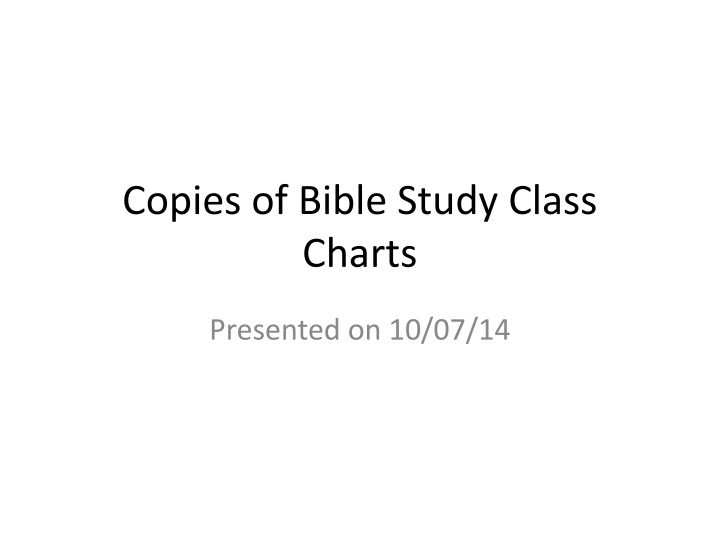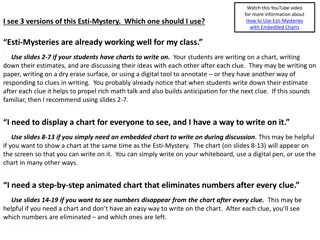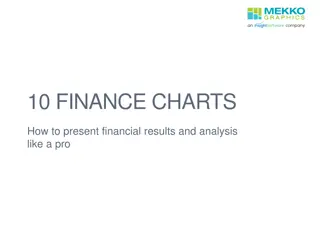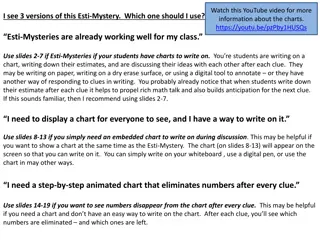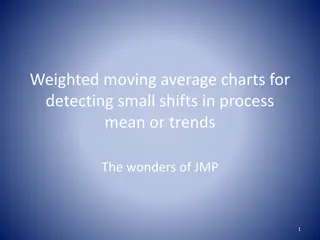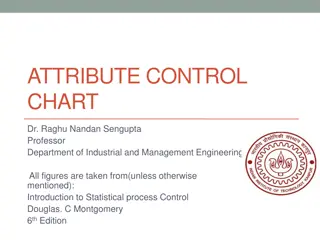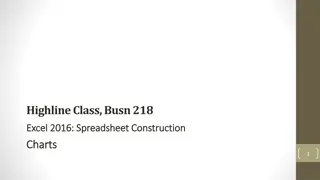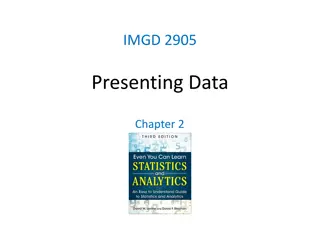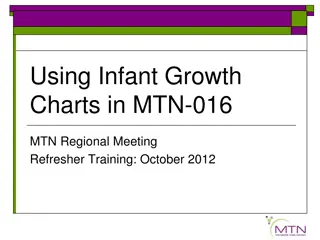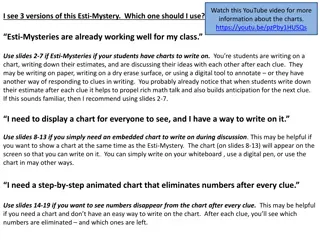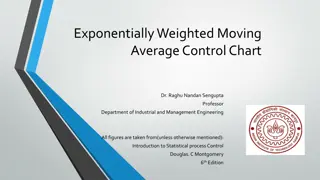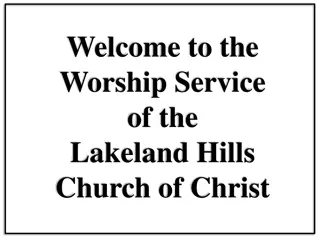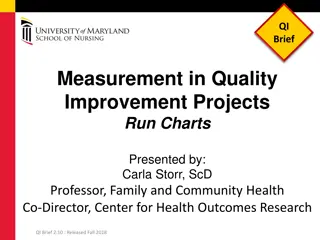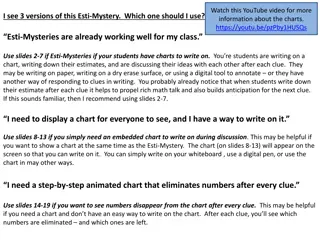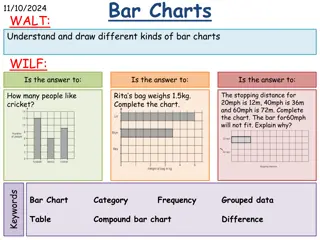Bible Study Class Charts & Review
In this Bible study class, charts and topics on Luke's gospel, Acts, and the prophecies of Daniel were covered. The discussions included Jesus' final appearance, His ascension, the mission to preach the gospel, and the prophetic visions of Daniel regarding kingdoms and Christianity's rise to power without warfare.
Download Presentation

Please find below an Image/Link to download the presentation.
The content on the website is provided AS IS for your information and personal use only. It may not be sold, licensed, or shared on other websites without obtaining consent from the author.If you encounter any issues during the download, it is possible that the publisher has removed the file from their server.
You are allowed to download the files provided on this website for personal or commercial use, subject to the condition that they are used lawfully. All files are the property of their respective owners.
The content on the website is provided AS IS for your information and personal use only. It may not be sold, licensed, or shared on other websites without obtaining consent from the author.
E N D
Presentation Transcript
Copies of Bible Study Class Charts Presented on 10/07/14
Reminder Bible Study will meet next Tuesday
Review Last week we looked at the ending of Luke s gospel (Lk 24:36-53) The final appearance of Jesus in the upper room where he left his peace and ate some fish to demonstrate his real presence Opened their minds to understand the scriptures about himself Gave them the mission to preach the gospel from Jerusalem to all the world Directed them to remain in the city until they received the power from on high (the Holy Spirit) He blessed them and then was carried up into heaven The Apostles returned joyfully to Jerusalem
Review (Cont) Acts 1:1-9 Theophilus a greeting The 40 days in Galilee before returning to Jerusalem He spoke of the arrival of the Kingdom of God (Israel) Refused to tell them when that would happen Gave them the mission to preach the gospel in Jerusalem, Galilee and Samaria and to the end of the earth He was lifted up and a cloud took him away Pope Benedict XVI s discussion of the glory cloud
Acts 1 (Cont) What else does the departure of Jesus on the clouds make us think of? It reminds us of Jesus promise concerning His coming (second coming) on the clouds (Lk 21:27) In Hebrew and Greek the words to go or come or went or came are the same The question was where was Jesus going when he went away? To answer this we must go back and look again at the Book of Daniel where we find one like the son of man taking his throne in a kingdom that shall not be destroyed
The Prophesies of Daniel Daniel: Interprets the dream of the King of Babylon concerning a statue made from different metals Has his own dream of the four great beasts coming out of the sea Both dreams represent the four temporary kingdoms each conquered (in war) by the sword existing between the Babylonian captivity and the arrival of the Christ Eventually the 4thKingdom (Rome) is converted by the fifth Kingdom (Christianity) But this last kingdom will come about in a different manner than the others as it comes to power without the use of the sword
The Prophesies of Daniel (Cont) Dan 2 Statue Gold Silver Bronze Iron Empire Babylon Medo-Persian Greek Rome Here we see a fifth empire being described as a small stone not made by human hands that becomes the great Kingdom of God which is the Church
The Prophesies of Daniel (Cont) Dan 7 Beasts Lion Bear Leopard Beast w iron teeth Empires Babylon Medo-Persian Greek Rome Although this dream is very similar to the king s dream in Dn 2 it is followed by a description of the final kingdom
The Prophesies of Daniel (Cont) The four empires (Dn 2 & 7) used earthly tactics to gain power by killing as many of the soldiers of the previous empire as possible This new kingdom will come about in a totally different manner: First, the Romans will continue to use these earthly tactics in an attempt to defeat this heavenly kingdom They persecute and kill many of the Christian martyrs who not only do not fight back with swords but use prayer which is more powerful than the sword This eventually results in the heavenly kingdom conquering of the Roman Empire over a period of a couple of centuries (the small stone of Dn 2) So what is important in Acts 1 is that the disciples see Jesus (one like the son of man) going into the clouds from which he shall return in the manner described in Dn 7
The Prophesies of Daniel (Cont) In Dn 7 we are introduced to one like the son of man: One like the Ancient of days (God) takes his throne One like the son of man came on the clouds of heaven and will have dominion over all nations forever Jesus refers to himself as son of man in reply to the High Priest s question if he is the Christ (Mt 26:64) We see that Jesus is one like the son of man coming on the clouds (Mt 24:29-31; Mk 13:24-27; Lk 21:25- 27) This Kingdom of God referred to in Daniel is the fulfillment of God s promise to David in 2 Sam 7:11-14
Son of Man The term son of man, could be understood in the following five different ways: A human being The son of Adam (man) A prophet (Elijah, Jeremiah) The messiah The divine figure and messiah from Daniel 7:13-14 The key to understanding the importance of the term Son of Man can be seen in the often used phrase He who has ears to hear let him hear, which allowed everyone to interpret son of man from his own point of view (Mt 13:43)
Son of Man (Cont) What was so great about this term is that it was intentionally ambiguous: Herod could say Jesus the son of man is no big deal Pilate could say that he did not care what he called himself At Jesus trial the High Priest tears his garment because he understands that Jesus is quoting from Dan 7:13 (Mt 26:63-64; Mk 14:53-64) It also reflects Jesus wisdom and political savvy because Jesus knew where this title would take them
Son of Man (Cont) Jesus can thus be seen meeting each of these definitions depending on one s faith or ability to hear ( He who has ears let him hear Mt 13:9) Clearly he is a human being For those who had better hearing he is like Ezekiel the prophet who is called son of man more than 40 times To those who had the best hearing (the apostles) Jesus is the awaited messiah and the son of God For us he is: a human, the son of Adam, a prophet, the Messiah, and divine
Acts 1 (Cont) The 1stCentury Christians needed to understand what was happening to them (persecutions) as it appeared that they were reliving what had happened to the martyred Apostles: Paul was stoned James was beheaded All of the Apostles except John was martyred The early Christians were being martyred all over the empire It began in earnest at the time Luke was writing his gospel (early 60ies) Next came the persecutions of Nero and his successors culminating with Domitian (81-96) during the time John was writing The Revelation focusing on these persecutions This changed in 315 A.D. when Christianity was accepted by the Roman Empire fulfilling the prophesies
Acts 1 (Cont) Acts 1:10-12 And while they were gazing into heaven as he went, behold, two men stood by theme in white robes and said Men of Galilee, why do you stand looking into heaven? This Jesus who was taken up from you into heaven, will come in the same way as you so him go into heaven a Sabbath day s journey away Obviously these are angels who can be seen throughout the Old Testament The message is that now that he has gone back to heaven you Apostles have work to do A Sabbath day s journey is = to about of a mile
Acts 1 (Cont) Acts 1:13-14 and when they had entered, they went up to the upper room, where they were staying, and with his brethren Luke presents the list of the Apostles starting with Peter as one of the 12 Peter s role is like the oldest son in a large family who is responsible for the family when the father leaves We also see the women and Mary the mother of Jesus These women were those who support Jesus and the Apostles throughout their journeys Brothers here most likely refers to cousins or step brothers of Jesus
Acts 1 (Cont) Acts 1:15 In those days Peter stood up among the brethren (the company of persons was in all about a hundred and twenty), Brethren here could be a reference to the community of believers Why 120? It could have been just a number or It could reflect that the Kingdom of Israel is developing as the 12 Apostles are expanding tenfold Also it could be a reflection back to the 12 tribes of Israel
Acts 1 (Cont) Acts 1:16-18 Brethren the scripture had to be fulfilled he burst open in the middle and his bowels gushed out This is different from Matthew s version where we see Judas hanging himself (Mt 27:5) Matthew depicts Judas death in the same manner as Ahitophel who betrayed David in the Old Testament (2 Sam 17:23) These are not irreconcilable since falling is often the end process of an extended hanging Each story is intended to evoke different images Matthew makes the connection to the betrayer of David which his audience would know Acts can be seen as the fulfilment of the death of Greek King Antiochus who was the great enemy of Israel at the time of the Maccabees (2 Macc 9:5-9)
Acts 1 (Cont) Acts 1:19-20 And it became known to all the inhabitants of Jerusalem, so that the field was called in their language Akeldama, that is, Field of Blood (Mt 27:8) For it is written in the book of Psalms, .His office let another take Ps 69:25 Ps 109:8 This indicates that some of the early Christians were close to the Pharisees as they believed that the Psalms were inspired writings Many of the 1stCentury Jews and early Christians memorized the Psalms (Unfortunately most Christians today are not familiar with the 150 Psalms) Ps 22 from the Cross Satan quotes from Ps 91:11-12 (13) during the Temptation of Jesus (Mt 4:6)
Acts 1 (Cont) Acts 1:21-22 So one of the men who have accompanied us during all the time that the Lord Jesus went in and out among us, a witness of his resurrection This covers the period from the Baptism of Jesus to his Ascension Second in importance to the early church, after the ascension, was the theophany at his Baptism in the Jordan Baptism and resurrection are related we believe in one baptism and the resurrection of the dead Nicene Creed Baptism is our resurrection
Acts 1 (Cont) Acts 1: 23-26 And they put forward two, Joseph called Barsabbas and Matthias . And they cast lots for them He was enrolled with the eleven apostles In Acts 1:15 Peter stood up and spoke from his special role as leader of the 12 Casting lots indicates their faith in the God of History to make His decision known to the group This was common in the Old Testament where people asked God for a sign Gideon fleece
Acts 1 (Cont) St Matthias was born in Judea sometime during the 1st century. He was chosen by God to replace Judas as one of the 12 Apostles by the casting of lots. This calling was unique as it was not made personally by Jesus. He was one of the seventy disciples of Jesus who had been with Jesus from his baptism by John until the ascension. Tradition says that he preached the Gospel in Judea, Aethiopia (modem day Georgia) where he was stoned to death. Another tradition says that he preached the Gospel in Ethiopia. A third tradition states that he was stoned at Jerusalem by the Jews. His death was in 80 A.D.
Transition We will now continue this story of the early Church by looking at Acts 2
Acts 2 Acts 2:1 When the day of Pentecost had come, they were all together in one place This was the 1stPentecost of the Church But not the 1stPentecost, for Pentecost was the second of the three major feasts of ancient Israel Passover Pentecost Booths Similar harvest feasts existed among the pagans See Ex 23:14-17
Acts 2 (Cont) The historical settings for the three feasts Passover Unleavened Bread A remembrance of the final plague against Egypt resulting in the freeing of Israel (Ex 12) Pentecost A remembrance of God, for the second time, giving the Law to Moses on Mt Sinai after the golden calf incident (Ex 19-34) Booths A remembrance of God watching over Israel during their 40 years of wilderness from Mt Sinai to entrance into the Promised Land (Nu 13-14) Other Summaries of three feasts: Ex 34:18-24 Lv 23:4-36; Du 16:1-17
Acts 2 (Cont) Passover is: The first major feast of the Jewish calendar An early spring feast A harvest feast celebrating the beginning of the barley harvest A spring feast when the first fruits of the barley begins to grow along with the wheat A commemoration of God bringing the people of Israel out of Egypt Feast of Unleavened bread begins the Passover
Acts 2 (Cont) Pentecost is: The second of the three major feasts of the Jewish calendar The 50thday after the feast of Passover A summer feast A harvest feast celebrating the first fruits of the wheat harvest and began 7 weeks after the waving of the sheaf of the Feast of Unleavened Bread A commemoration of God giving the Law to Moses on Mt Sinai Also known as the Feast of Harvest; Feast of Weeks;
Acts 2 (Cont) Tabernacles is: The third major feast of the Jewish calendar A fall feast A commemoration of God dwelling among the people of Israel during their 40 years sojourn in the desert A harvest feast celebrating the beginning of the fruit harvest including grapes, olives (wine and oil) almonds, pomegranates, and figs A fall feast Also know as the Feast of Ingathering; Booths; Succoth
Acts 2 (Cont) What was the importance of first fruits? First fruits had to be offered to God according to the religious practice of Israel and the pagans This was done in hopes that God would provide a good harvest which had to sustain them for the rest of the year The Jews were also required to sacrifice the first male animal and consecrate the first born son to God (Ex 34:19-20)
Acts 2 (Cont) Acts 2:1 When the day of Pentecost had come, they were all together in one place The 12 Apostles (along with the 120, the women and the Blessed Mother) were all gathered together in Jerusalem just as the people of Israel had been gathered together at Mount Sinai when Moses received the Law from the God of Israel at the 1stPentecost
